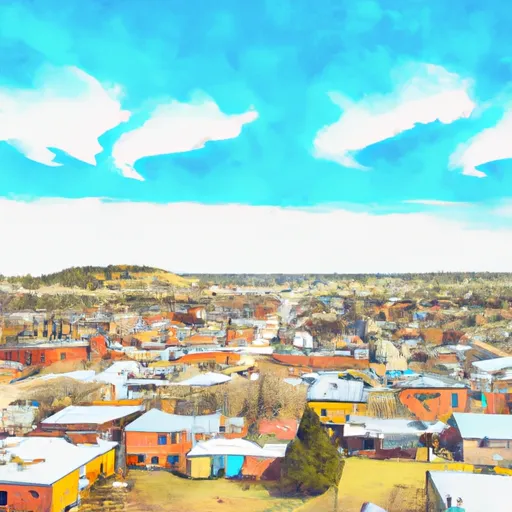-
 Snoflo Premium
Snoflo Premium
Get unlimited access to all our content
With no Ad interruptions! - Start Your Free Trial Login with existing account
Ignacio
Eden Index
Climate
8.1
•
Recreation
2.9
•
Community
2.4
•
Safeguard
4.9/10

Ignacio, Colorado is a small town located in La Plata County. Situated in the southwestern part of the state, Ignacio experiences a semi-arid climate characterized by hot summers and mild winters. Summers are typically hot with temperatures averaging in the mid-80s Fahrenheit (29°C), while winters are mild with temperatures ranging from the mid-20s to mid-40s Fahrenheit (-4°C to 7°C). The area receives around 14 inches (36 cm) of annual precipitation, with the majority falling during the summer months.
Ignacio benefits from its proximity to the Animas River, which flows nearby. The hydrology constituents in the region include the Animas River, which is known for its excellent fishing opportunities, especially for trout. Outdoor enthusiasts can enjoy activities such as fly fishing, kayaking, and rafting on the river. Additionally, the surrounding area offers several hiking and biking trails for individuals seeking to explore the picturesque landscapes of the nearby San Juan National Forest.
Overall, Ignacio provides a favorable climate for outdoor activities, making it an attractive destination for those who enjoy fishing, water sports, hiking, and biking.
What is the Eden Index?
The Snoflo Eden Index serves as a comprehensive rating system for regions, evaluating their desirability through a holistic assessment of climate health, outdoor recreation opportunities, and natural disaster risk, acknowledging the profound impact of these factors on livability and well-being.
Climate Health Indicator (CHI): 8.1
Ignacio receives approximately
347mm of rain per year,
with humidity levels near 52%
and air temperatures averaging around
9°C.
Ignacio has a plant hardyness factor of
6, meaning
plants and agriculture in this region thrive during a short period during spring and early summer. Most
plants will die off during the colder winter months.
By considering the ideal temperature range, reliable water supplies, clean air, and stable seasonal rain or snowpacks, the Climate Health Indicator (CHI) underscores the significance of a healthy climate as the foundation for quality living.
A healthy climate is paramount for ensuring a high quality of life and livability in a region, fostering both physical well-being and environmental harmony. This can be characterized by ideal temperatures, reliable access to water supplies, clean air, and consistent seasonal rain or snowpacks.
Weather Forecast
Streamflow Conditions
Upper San Juan
Area Rivers
Upper San Juan
Snowpack Depths
Upper San Juan
Reservoir Storage Capacity
Upper San Juan
Groundwater Levels
Recreational Opportunity Index (ROI): 2.9
The Recreational Opportunity Index (ROI) recognizes the value of outdoor recreational options, such as parks, hiking trails, camping sites, and fishing spots, while acknowledging that climate plays a pivotal role in ensuring the comfort and consistency of these experiences.
Access to outdoor recreational opportunities, encompassing activities such as parks, hiking, camping, and fishing, is crucial for overall well-being, and the climate plays a pivotal role in enabling and enhancing these experiences, ensuring that individuals can engage in nature-based activities comfortably and consistently.
Camping Areas
| Campground | Campsites | Reservations | Toilets | Showers | Elevation |
|---|---|---|---|---|---|
| Middle Mountain - Vallecito Reservoir | 24 | 7,699 ft | |||
| Pine Point - Vallecito Reservoir | 30 | 7,709 ft | |||
| North Canyon - Vallecito Reservoir | 21 | 7,708 ft | |||
| Miller Creek | 12 | 8,171 ft | |||
| Graham Creek | 25 | 7,725 ft | |||
| Cottonwood - Navajo Lake State Park | 47 | 5,688 ft | |||
| Sims Mesa - Navajo Lake State Park | 44 | 6,136 ft | |||
| Old Timers - Vallecito Reservoir | 11 | 7,692 ft | |||
| Pine River - Navajo Lake State Park | 103 | 6,264 ft | |||
| Simon Canyon Dispersed | None | 5,706 ft |
Nearby Ski Areas
Catastrophe Safeguard Index (CSI):
The Catastrophe Safeguard Index (CSI) recognizes that natural disaster risk, encompassing floods, fires, hurricanes, and tornadoes, can drastically affect safety and the overall appeal of an area.
The level of natural disaster risk in a region significantly affects safety and the overall livability, with climate change amplifying these risks by potentially increasing the frequency and intensity of events like floods, fires, hurricanes, and tornadoes, thereby posing substantial challenges to community resilience and well-being.
Community Resilience Indicator (CRI): 2.4
The Community Resilience Indicator (CRI) recognizes that education, healthcare, and socioeconomics are crucial to the well-being of a region. The CRI acknowledges the profound impact of these elements on residents' overall quality of life. By evaluating educational resources, healthcare accessibility, and economic inclusivity, the index captures the essential aspects that contribute to a thriving community, fostering resident satisfaction, equity, and social cohesion.

